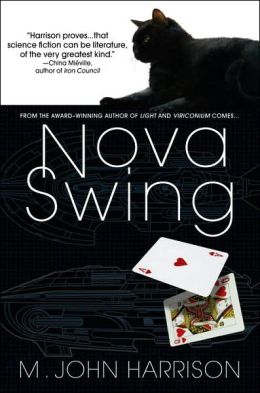One of the great attractions of the weird, both in its old and new varieties, is its attempt to describe the indescribable, to conceive the inconceivable, and to write the unwritable. For those in love with language, weird fiction drives that the word to its very limits, to that point where it breaks down.
H. P. Lovecraft is famous for his attempts to describe the indescribable. His works are full of angles which make no sense, creatures which cannot be explained (though in his later work he made an attempt), and horrors that can only be summed up in waterfalls of adjectives: eldritch and cyclopean and gibbous and squamous and, most important for our topic here, indescribable and unnameable.
But it is perhaps M. John Harrison who has been the most successful of us, particularly in his far future science fiction novel Nova Swing.
Nova Swing centres around a mysterious ‘event site’, a kind of quantum zone (one suspects) that fell from the Kefahuchi tract above, onto the city of Saudade. It’s a place where things are painfully, awfully, weird. Indeed, it’s a place where humans are not meant to go—an exemplar of the alien. We learn early on that the site had ‘streets transposed on one another, everything laid down out of sync one minute to the next. Geography that doesn’t work… Lost dogs barking day and night. Everything struggling to keep afloat.’ Here Harrison’s language slips between the spacial and temporal, to the eerie image (lost dogs barking) and finally to metaphor: everything struggling to keep afloat. Later, we learn that ‘The air’s like uncooked pastry. It’s not a smell in there it’s a substrate. In every corner there’s a broken telephone nailed to the wall. They’re all labelled Speak but there’s no line out. They ring but no one’s there.’
In writing the weird, it’s essential to provide just enough information for the reader to form some kind of outline, and yet not quite enough for the image to be plain. In the distance between the two, the reader’s imagination—and unconscious—fills in the gap.
This balance is essential in horror writing (and particularly film) too: you don’t want to show the entire monster. Rather, you want to suggest: a glimpse of a great roving eye in the darkness, quickly covered over by a nictating membrane, the sound of scrabbling claws, something slithering.
One of the reasons this technique is so powerful is that the reader will fill in the missing pieces with what frightens them the most. The trick, for the writer, is to choose exactly the right details to convey. Harrison’s gives us prismatic light and impossible topography and lost dogs barking day and night. The missing information eats at us: Why are the dogs barking? Are they upset or angry? We know for sure they’re lost, and we know it’s a melancholy image, disturbing, yet not quite as disturbing as the broken telephone’s nailed on the wall, which break our notions of human logic. They ring but no ones there—but communication is the entire point of a telephone (which is why prank callers who don’t speak are also frightening).
Though not the first to try his hand at the idea of a strange or alien zone – the Strugatsky brothers Roadside Picnic is an early version of it, from what I hear Jeff VanderMeer’s Southern Reach books a recent one—what strikes us about Harrison’s take is the way his technical mastery combines with his typical concerns with loss (and not only represented by lost dogs or broken phones). For Harrison’s characters are drawn, often by some unclear inner need or pain, to the site. And the site irrevocable damages them. As Nietzsche once wrote, when you gaze into the abyss, the abyss also gazes into you.
In Nova Swing,Vic Serotonin guides people on dangerous trips to the site. At the same time, it seems that things—in the shape of odd people — are escaping from the site too. The interaction of the human and the alien (as incarnated in the quantum space of the site, and the people and objects it emits) lies at the heart of the novel. Of course, in the climactic scenes of the book, Harrison takes us into the heart of the Site. I won’t give away any spoilers, except to say, that journey is a virtuoso performance of the weird.
Some find Harrison’s work too cold, like a distant glittering star. How can we sympathise with his collection of losers and misfits, who seem so burned by life that we can only see them through their bands of scar tissue? It is true that Harrison makes us work, but what rewards he offers us! Again and again I can return to his stories, to marvel at this or that aspect of them. Their density and complexity repays our visits. And for a writer, he shows us just what we can do with language—just how far we can push it.
Rjurik Davidson is a winner of the Ditmar Award as Best New Talent and the Aurealis Award for his short fiction. His first book was a collection, The Library of Forgotten Books. A columnist, and a literary and film critic, he lives in Melbourne, Australia. Unwrapped Sky is his first novel.










